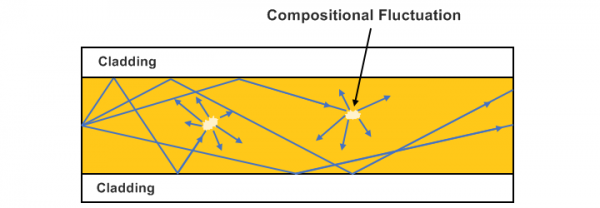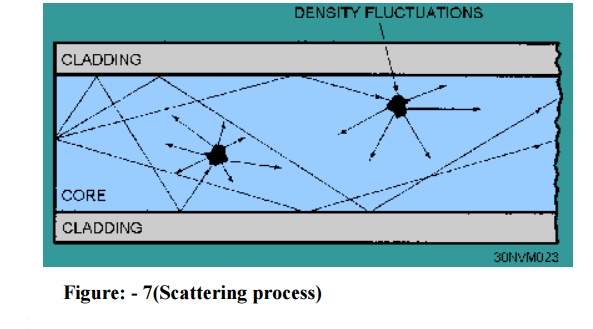Basically, scattering losses are caused by the interaction of light with density fluctuations within a fiber. Density changes are produced when optical fibers are manufactured. During fabrication, regions of high and low molecular densities are created relative to the average density of the fiber. Light traveling through the fiber interacts with the density fields as shown in the light, then is partially scattered in all directions.
In commercial fibers operating between the 700-nm and 1600-nm wavelengths, the main source of loss is what is called Rayleigh scattering. As the wavelength increases, the loss due to Rayleigh scattering decreases. If the defect size is greater than one-tenth of the wavelength of light, the scattering mechanism is called Mai scattering.

Linear Scattering loss:
Rayleigh Scattering: This happens because the silicon dioxide molecules have some freedom when they are adjacent to each other. Thus, setup at irregular positions and distances with respect to each other when the glass cools rapidly during the final stage of the fabrication process. Those structural differences are perceived by light as variations in the refractive index, causing the light to reflect in different directions—that is, scatter. Rayleigh scattering is the scattering of light by particles much smaller than the wavelength of the light, which can be individual atoms or molecules. Rayleigh scattering is a process in which light is scattered by a small spherical volume of varying refractive index, such as a particle, bubble, droplet, or even by density fluctuations. As light travels across the core, it interacts with the silica molecules in the core. Rayleigh scattering is the result of these elastic collisions between the light wave and the silica molecules in the fiber. Rayleigh scattering is responsible for about 96 percent attenuation in optical fibers. Many optics company use cube beamsplitters and polarizer to manufacture optics.

Causes of Rayleigh Scattering:
- It happens because of the non-ideal physical properties of the manufactured fiber.
- It happens because of the inhomogeneities present in the cladding and core.
Mie Scattering: The imperfect cylindrical structure of the fiber and the imperfections such as irregularities, diameter fluctuations, stresses and bubbles at the core-cladding interface can create a linear scattering known as Mai scattering. Mie scattering is the scattering of light by particles approximately equal to the wavelength of the light, which can be individual atoms or molecules.
 Макияж, прически, маникюр, уход за лицом и телом SalonBeauty24.info
Макияж, прически, маникюр, уход за лицом и телом SalonBeauty24.info



